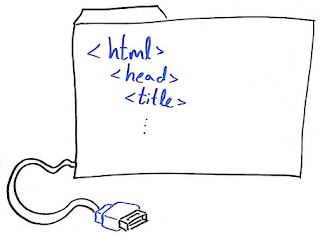 |
| (Illustration by Tsahi Levent-Levi, CC BY 2.0) |
AJAX
Ajax (Asynchronous JavaScript and XML) is a way of programming web pages with data, content, and design merged together resulting in interactive web applications. For example: AJAX allows one section of page to stay up to date by getting new information regularly at a set frequency without the need for the website visitor to keep refreshing the entire page.
blogs
Blogs are an online method of sharing content. They are often used by businesses as a marketing tool. Blogs generally consist of short articles posted on a regular basis.
browser
A browser is a software program used to view websites. Common browsers include Safari, Chrome, Firefox, and Internet Explorer (IE).
browser compatibility
Browser compatibility means when a website runs correctly on different web browsers. It also is used when a website looks good (or acceptable downgrade) is all or the most common web browsers through testing, adjustments, and expertise.
content management system (CMS)
A CMS is a web-based software application that allows your staff to maintain your website content in-house without advanced technical expertise or knowledge of HTML. Changes and additions can be made at any time, immediately, and without desktop software. It serves as an affordable alternative for organizations that require significant, time-sensitive, and/or routine maintenance. TBH Creative has developed its own flexible and robust CMS.
cascading style sheets (CSS)
CSS is a style sheet language used to describe the presentation(the look and formatting) of a document written in a markup language. It is applied web page data or content written in HTML and XHTML. CSS separates the design and style from the page information resulting in great benefits such as quicker load time, easier edits, and simplified redesign process. Font changes, background colors, and more can be changed in one CSS file in a matter of minutes.
domain name
Also known as an URL, a domain name is a www address. Simply put, it’s what you type in your browser’s address bar. For marketing purposes, a domain name is your web address. A domain name should be relevant to your company, organization or product, short, catchy, and easy to remember. Technically, a domain is the sequence of words, phrases, abbreviations, or characters that serves as the Internet address of a computer or network.For example, TBH Creative’s our domain name is tbhcreative.com.
Facebook is a social network service where users create personal profiles and connect to other users as friends.
graphics interchange format (GIF)
GIF is a popular file format for web graphics. GIF is the ideal choice for displaying graphics with large areas of solid color, such as logos, without any loss in quality. GIFs only support 256 colors, but they allow for transparency. GIFs can also be animated.
Google Analytics
Google Analytics is a free service provided by Google that generates demographic statistics about the visitors of a website, such as how they visited and how long they were on the page.
hypertext markup language (HTML)
HTML is the structural language of web pages.
javascript
Javascript is an object-oriented scripting language used to enhance web pages.
joint photographic experts group (JPG)
JPG is a popular file format web graphics. JPG is the ideal choice for displaying photographs, but JPG file will have a lossy compression.
operating systems (os)
Operating systems are software that run on computers. An OS manages computer hardware. Some examples include Microsoft’s Windows, Mac’s OSX, GNU/Linux.
pagerank
PageRank is what Google uses to determine the importance of a web page. It’s one of many factors used to determine which pages appear in search results.
portable network graphics (PNG)
A PNG is a file format used for displaying graphics that is similar, but better than a GIF. PNGs combine some of the best features of both GIF and JPG formats. PNGs’ compression level is great, without any loss of quality. PNGs are often used for transparent graphics or logos.
really simple syndication (RSS)
RSS is an XML-based format used for content distribution and syndication. Subscribing to RSS feeds allows you to receive custom, up-to-date information from your favorite online content sources without having to regularly check the site for updates.
search engine optimization (SEO)
SEO is the name given to the activity of optimizing web pages or websites in order to make them more search engine-friendly to ultimately achieve higher positions in search results. No one can guarantee a #1 ranking on Google. Be careful if a company is secretive or won’t clearly explain what they intend to do.
social networking
Social networking is the name given to networking online for fun and business purposes. Think of the six degrees of separation concept. Social networking produces interconnected Internet communities that help members make contacts through others that they would be unlikely to have met otherwise or realize common connections.
Twitter is a social network/microblogging service allowing its users to send and read other users’ messages, also known as “tweets.” Tweets are restricted to 140 characters.
web hosting
Web hosting is the term used to describe where your website files live on the Internet.
Still have questions? TBH Creative is an Internet Strategy Agency and Indianapolis web design company. We design and develop websites that are results-driven and creative. Contact us for a website planning consultation.
